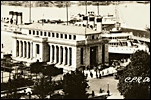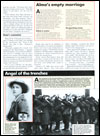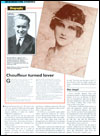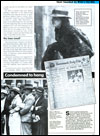|
Francis Mawson Rattenbury
|
|
BC's foremost institutional architect,
Francis Mawson Rattenbury, is remembered for his landmark buildings. But he's also remembered for his brazen lifestyle and tragic death |
|
RBCM & A
|
F-02163
|
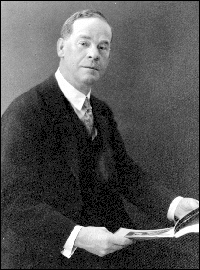 |
|
F M Rattenbury
circa 1924 |
|
|
|
|
|
| Francis Mawson Rattenbury was born on October 11, 1867 in Leeds, England. | ||
| At the age of twenty he joined his uncle's architecture firm, Lockwood and Mawson, in Bradford where he articled for the next five years, only to realize that he craved more that the secure but staid future that awaited him as an architect in Bradford. | ||
| He had heard that the West Coast of Canada was a land of opportunity so, in 1892, twenty-five-year-old Rattenbury found himself in Vancouver just when the provincial government was advertising a design competition for the legislature buildings in Victoria. | ||
| Rattenbury applied along with 66 others and won, based on a remarkable design concept and a falsified work history record. | ||
| After many delays and contractual disputes, the parliament buildings were officially opened February 10, 1898 to universal praise. Rattenbury had earned a $40,000 commission and was itching to do something with it. | ||
| 1898 was the height of the Klondike gold rush, and Rattenbury smelled opportunity. He embarked on a series of schemes ranging from providing cattle to hungry miners to establishing a transportation system to make Dawson City more accessable. But, by the time his infrastructure was in place Dawson City was passé and Nome, Alaska, was the new destination for gold seekers. Rattenbury was left high and dry, and lost a fortune. | ||
| Discouraged with his adventure in free enterprise, Rattenbury regrouped in Victoria, built his family home1, Iechinihl, in Oak Bay and returned to architecture for a living. | ||
| Rattenbury's work on Victoria's parliament buildings had instantly established his reputation as the province's foremost architect of civic and institutional buildings. He received commissions for projects outside of Victoria — Vancouver, the interior of BC, and Alberta. Most significantly, he was contacted by the CPR to help with additions to Hotel Vancouver, its hotel in Vancouver — an endorsement that made Rattenbury CPR's man in western Canada. In 1901 he earned over $100,000 in commissions. | ||
| With capital in the bank and once again brimming with confidence, Rattenbury was ready for another adventure in free enterprise. | ||
| In 1902 it was announced that a second railway line — the Grand Trunk Pacific Railway — was being planned with its western terminus at Prince Rupert, a city not yet built. Again, Rattenbury smelled opportunity and quietly purchased vast tracts of land along the intended railway route. Further, he was commissioned by the GTPR to design a chain of hotels along the route. | ||
| In 1903 the CPR gave Rattenbury the design contract for their hotel in Victoria. The Empress Hotel officially opened on January 21, 1908, but Rattenbury was relieved of his duties in December 1907. The CPR had learned of his involvement with their competition, the GTPR. | ||
| Rattenbury started designing private homes for the affluent in Oak Bay and throughout the city. In 1907 he became one of the four first councillors in Oak Bay, which was incorporated as a municipality in 1906. | ||
| In his travels to England and Europe he became aware of the importance of urban planning and the need for parks and green spaces. He was discouraged to see Victoria's unregulated growth as he envisioned tourism, not industry, as being the foundation of the city's economic future. Unable to affect change at the civic level, he focussed on the municipal level. | ||
| Consequently, in 1913, Rattenbury became reeve of Oak Bay and immediately implemented the concepts of municipal-controlled growth2 and the creation of parks and green space.3 | ||
| As satisfying as 1913 may have been for Rattenbury,1914 marked the beginning of the end for both his personal and financial worlds. | ||
| In 1914 Britain declared war on Germany, which immediately killed the Grand Trunk Pacific scheme. In 1919 the GTP declared bankruptcy. His vast land holdings along the intended GTP route were now worthless. Even worse, his holdings were now being heavily taxed by the provincial government. | ||
| And his marriage was on the rocks. Rattenbury started drinking heavily. | ||
| There was little work for architects during the war years so he closed his office. When the economy started to recover, Rattenbury lacked any desire to resume his career. | ||
| Rhodri Windsor Liscombe in Building the West observed: | ||
|
||
| But in 1921 his interest was piqued when approached by the Victoria Chamber of Commerce with its desire for a civic swimming pool. This was something he had dreamed of doing. Rattenbury prepared some inspired sketches of a multi-faceted amusement complex and, after two years of bureaucracy, his concept for the Crystal Garden received the green light from taxpayers on December 29, 1923.4 | ||
| That evening a celebration was held at the Empress Hotel and Rattenbury was the centre of attention. He felt rejuvinated. On that evening, and in that frame of mind, he met a woman who would change his life | ||
| Alma Packenham was a vivacious 26-year-old, less than half of Rattenbury's 56 years. She was beautiful, musically talented, and uninhibited. She smoked in public and was reputed to use cocaine. Rattenbury was bewitched. She was everything he wasn't. They started seeing each other and became inseparable over the next two years, despite his marriage to Florrie. For this Rattenbury was chastised by all who knew him. | ||
| In 1925 Rattenbury divorced Florrie and married Alma, who gave him a son, John, in 1928. | ||
| Florrie died in 1929, which only underscored Rattenbury's mistreatment of her in the eyes of Victoria society. He was totally shunned. | ||
| Realizing he had no future in Victoria — the city he shaped more than any other architect — Rattenbury, Alma and their son John left for England in 1930. | ||
| They rented a house, Villa Madeira, in Bournemouth, England. | ||
| The were financially comfortable based on Rattenbury's savings, but there were no architectural prospects and little if any income. But they could afford a part-time maid. | ||
| While Alma's music career blossomed with recordings and performances, Rattenbury reflected more on his life and became increasing disconsolate. Alma was revitalized and Rattenbury drank more. | ||
| In 1934 they hired a chauffeur to help with the driving when Rattenbury wasn't able. | ||
| Alma seduced the chauffeur, 18-year-old George Stoner, and arranged for him to move into the house. Stoner was sexually naive and, by reported accounts, not too bright. In his confused state of mind he became very jealous of the time Alma spent with her husband. | ||
| On one fateful evening — March 24, 1935 — while Rattenbury was asleep in his chair, Stoner crept up behind him and struck him on the head three times with a mallet, delivering mortal blows. | ||
| The murder trial at the Old Bailey dominated the tabloids and became a national scandal. The story created a huge following, with mixed sympathies: Who did it? | ||
| Stoner was found guilty of murder and sentenced to hang. Alma, although chastised for being an adultress, was found not guilty of any crime and released. | ||
| Despite her freedom, Alma was distraught. Four days later she found her way to the Avon River, waded in and resolutely stabbed herself six times before delivering a fatal wound. | ||
| Stoner's death sentence, because of public pressure, was commuted to life imprisonment. After serving seven years he was released in 1942 to join the army. He took part in the Normandy Invasion on June 6, 1944. | ||
|
|
||
| 1 Rattenbury married Florence Eleanor Nunn on June 18, 1898 and had a son Francis Burgoyne Rattenbury that same year. | ||
| 2 In 1913 Oak Bay council refused a building permit for the construction of a service station in Oak Bay, but the builders proceeded regardless. Council applied to the Court for a restraining injunction but was advised that the municipality had no powers to regulate the placing of any type of building in a particular location. | ||
| 3 In 1913 Oak Bay council acquired 3.5 acres of land for Willows Park | ||
| 4 Although Rattenbury conceived the idea for the Crystal Garden complex, much of the detail work, problem solving, and preparation of plans were the responsibility of fellow-architect, Percy Leonard James. | ||
|
Copyright © 2009–2010 Gary Wilcox Studios Incorporated
|
||
|
FURTHER READINGS
|
||
| Rattenbury Biographies | ||
| Barnett, A.A. and R. Windsor Liscombe. Francis Rattenbury in British Columbia: Architecture and Challenge in the Imperial Age (University of British Columbia Press:1983) | ||
| Reksten, Terry. Rattenbury (Sono Nis Press:1978) | ||
| Sauerwein, Stan. Rattenbury: The Life and Tragic End of BC's Greatest Architect (Altitude Publishing:2003) | ||
Rattenbury Related |
||
| Berton, Pierre et al. The Crystal Gardens: West Coast Pleasure Palace (Crystal Gardens Preservation Society:1977) | ||
|
PHOTOGRAPHS
|
A Selected Portfolio Of Rattenbury's Buildings
|
VICTORIA
click on image for enlargement |
||
|
Bank of Montreal
1896 |
Parliament Buildings
1898 |
CPR Terminal Building
1904 |
|
Empress Hotel
1908 |
CPR Terminal Building
(with PL James) 1924 |
Crystal Garden
(with PL James) 1925 |
|
OAK BAY
click on image for enlargement |
|
|
Iechinihl
1898 |
Oak Bay Hotel
1904 |
|
BRITISH COLUMBIA
click on image for enlargement |
||
|
Field
|
Nelson
|
Vancouver
|
|
Mt Stephen House
1903 |
Nelson Courthouse
1909 |
Vancouver Courthouse
1911 |
|
ARTIFACTS
|
|
Rattenbury's Murder Coverage in the British Press
click on page for enlargement |
|||
|
page 1
|
page 2
|
page 3
|
page 4
|
|
page 5
|
page 6
|
page 7
|
fromlReallLifelCrimes
EaglemosslPublications,lLondon,lEngland
©lMidsummerlBookslLtdl1993
|
RECOLLECTIONS
|
Recollections may be abridged for length and/or clarity
| I just finished reading the memoirs of a W H T Olive and in it Mr. Olive describes Mr. Rattenbury as the one who received funding from England to establish the Bennett Lake and Klondyke Navigation company. |
| Mr. Olive was a carpenter who worked on the BC legislature building in Victoria and was then hired to build three paddle wheelers, Flora, Ora, and Nora. |
| Mr. Olive became manager of the BL&KN company. Mr. Rattenbury also procured railroad right-of-way to by-pass a good part of the Yukon River, but it was never built. |
| Mr. Rattenbury and his financiers made extremely high profits from this venture according to Mr. Olive. |
| — Trevor Tocher |
Do you have any recollections of Francis Mawson Rattenbury?
If yes, please share them by using the form below
|
SUBMISSIONS
|
|
Do you have any
photos, artifacts or recollections of Francis Mawson Rattenbury? |
|
PLEASE CONTACT US Your contribution may become part of Oak Bay history! |
|
You can email us, with attachments if available |
|
OR
|
|
You can use the Online Submission Form, below
|
Thank You!
Return to section "R" of the Encyclopedia
The History of Oak Bay Website
A CENTENNIAL LEGACY PROJECT





